01-Introduction to Bioinformatics(生物信息学国外教程2010版) PPT课件
- 格式:ppt
- 大小:6.21 MB
- 文档页数:102
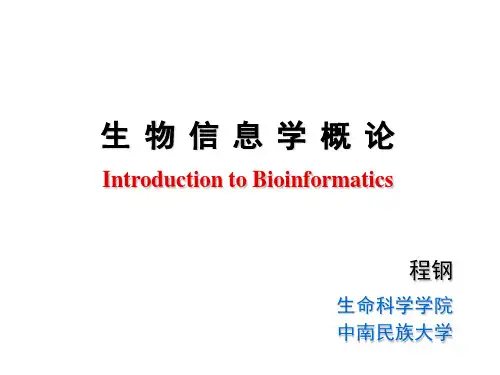
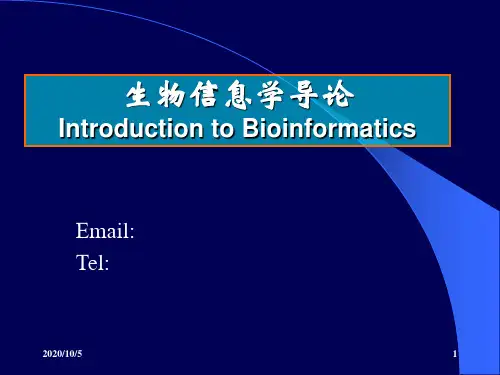
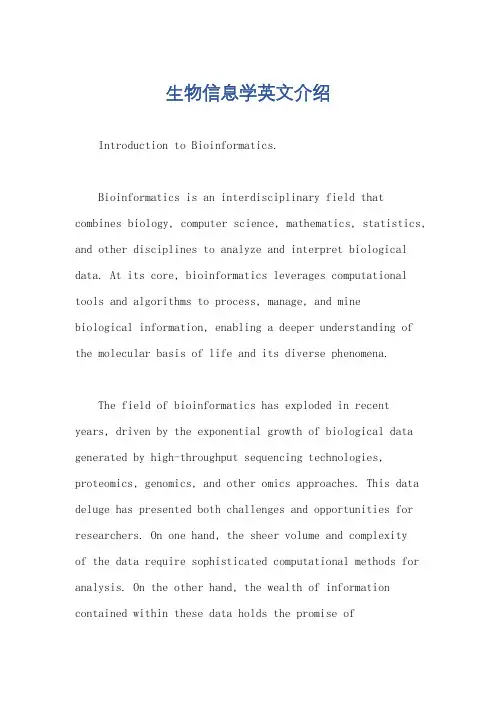
生物信息学英文介绍Introduction to Bioinformatics.Bioinformatics is an interdisciplinary field that combines biology, computer science, mathematics, statistics, and other disciplines to analyze and interpret biological data. At its core, bioinformatics leverages computational tools and algorithms to process, manage, and minebiological information, enabling a deeper understanding of the molecular basis of life and its diverse phenomena.The field of bioinformatics has exploded in recent years, driven by the exponential growth of biological data generated by high-throughput sequencing technologies, proteomics, genomics, and other omics approaches. This data deluge has presented both challenges and opportunities for researchers. On one hand, the sheer volume and complexityof the data require sophisticated computational methods for analysis. On the other hand, the wealth of information contained within these data holds the promise oftransformative insights into the functions, interactions, and evolution of biological systems.The core tasks of bioinformatics encompass genome annotation, sequence alignment and comparison, gene expression analysis, protein structure prediction and function annotation, and the integration of multi-omic data. These tasks require a range of computational tools and algorithms, often developed by bioinformatics experts in collaboration with biologists and other researchers.Genome annotation, for example, involves the identification of genes and other genetic elements within a genome and the prediction of their functions. This process involves the use of bioinformatics algorithms to identify protein-coding genes, non-coding RNAs, and regulatory elements based on sequence patterns and other features. The resulting annotations provide a foundation forunderstanding the genetic basis of traits and diseases.Sequence alignment and comparison are crucial for understanding the evolutionary relationships betweenspecies and for identifying conserved regions within genomes. Bioinformatics algorithms, such as BLAST and multiple sequence alignment tools, are widely used for these purposes. These algorithms enable researchers to compare sequences quickly and accurately, revealing patterns of conservation and divergence that inform our understanding of biological diversity and function.Gene expression analysis is another key area of bioinformatics. It involves the quantification of thelevels of mRNAs, proteins, and other molecules within cells and tissues, and the interpretation of these data to understand the regulation of gene expression and its impact on cellular phenotypes. Bioinformatics tools and algorithms are essential for processing and analyzing the vast amounts of data generated by high-throughput sequencing and other experimental techniques.Protein structure prediction and function annotation are also important areas of bioinformatics. The structure of a protein determines its function, and bioinformatics methods can help predict the three-dimensional structure ofa protein based on its amino acid sequence. These predictions can then be used to infer the protein'sfunction and to understand how it interacts with other molecules within the cell.The integration of multi-omic data is a rapidly emerging area of bioinformatics. It involves theintegration and analysis of data from different omics platforms, such as genomics, transcriptomics, proteomics, and metabolomics. This approach enables researchers to understand the interconnectedness of different biological processes and to identify complex relationships between genes, proteins, and metabolites.In addition to these core tasks, bioinformatics also plays a crucial role in translational research and personalized medicine. It enables the identification of disease-associated genes and the development of targeted therapeutics. By analyzing genetic and other biological data from patients, bioinformatics can help predict disease outcomes and guide treatment decisions.The future of bioinformatics is bright. With the continued development of high-throughput sequencing technologies and other omics approaches, the amount of biological data available for analysis will continue to grow. This will drive the need for more sophisticated computational methods and algorithms to process and interpret these data. At the same time, the integration of bioinformatics with other disciplines, such as artificial intelligence and machine learning, will open up new possibilities for understanding the complex systems that underlie life.In conclusion, bioinformatics is an essential field for understanding the molecular basis of life and its diverse phenomena. It leverages computational tools and algorithms to process, manage, and mine biological information, enabling a deeper understanding of the functions, interactions, and evolution of biological systems. As the amount of biological data continues to grow, the role of bioinformatics in research and medicine will become increasingly important.。
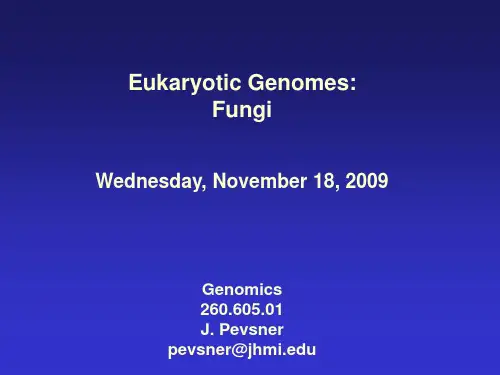

生物信息学英文教科书1. "Bioinformatics: A Practical Guide to the Analysis of Genes and Proteins" (Third Edition) by David W. MountThis textbook provides a comprehensive introduction to bioinformatics, covering topics such as sequence analysis, genomics, transcriptomics, proteomics, and systems biology. It includes practical examples and exercises to help readers apply the concepts.2. "Introduction to Bioinformatics" (Second Edition) by Arthur M. LeskThis book offers a broad overview of bioinformatics, including sequence analysis, database searching, phylogenetic inference, and genome analysis. It also covers bioinformatics tools and techniques used in experimental biology.3. "Bioinformatics for Dummies" by John M. Walker and Todd W. J. DavisThis beginner-friendly guide introduces the fundamentals of bioinformatics in an easy-to-understand manner. It covers topics like sequence alignment, database searching, and phylogenetic trees, with a focus on practical applications.4. "Computational Biology: A Practical Introduction to Bioinformatics and its Applications" by Udit Sharma and Navdeep KaurThis textbook provides a comprehensive overview of bioinformatics, including sequence analysis, genome annotation, protein structure prediction, and biological networks. It includes real-life examples and case studies.These textbooks offer in-depth coverage of bioinformatics concepts and techniques, and they can serve as valuable references for students, researchers, and professionals in the field. The specific choice of a textbook may depend on the reader's background, level of expertise, and specific interests within bioinformatics.。
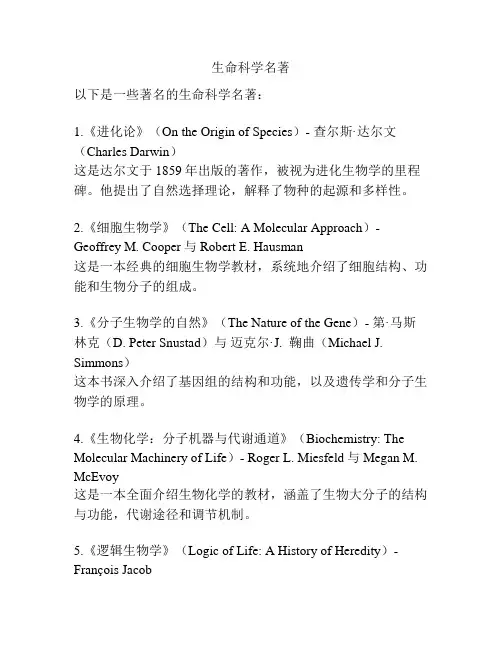
生命科学名著以下是一些著名的生命科学名著:1.《进化论》(On the Origin of Species)- 查尔斯·达尔文(Charles Darwin)这是达尔文于1859年出版的著作,被视为进化生物学的里程碑。
他提出了自然选择理论,解释了物种的起源和多样性。
2.《细胞生物学》(The Cell: A Molecular Approach)- Geoffrey M. Cooper与Robert E. Hausman这是一本经典的细胞生物学教材,系统地介绍了细胞结构、功能和生物分子的组成。
3.《分子生物学的自然》(The Nature of the Gene)- 第·马斯林克(D. Peter Snustad)与迈克尔·J. 鞠曲(Michael J. Simmons)这本书深入介绍了基因组的结构和功能,以及遗传学和分子生物学的原理。
4.《生物化学:分子机器与代谢通道》(Biochemistry: The Molecular Machinery of Life)- Roger L. Miesfeld与Megan M. McEvoy这是一本全面介绍生物化学的教材,涵盖了生物大分子的结构与功能,代谢途径和调节机制。
5.《逻辑生物学》(Logic of Life: A History of Heredity)- François Jacob这本书讲述了遗传学的历史发展,并探讨了基因表达和遗传信息在生物体内传递的原理。
6.《动物行为学原理》(Principles of Animal Behavior)- Lee C. Drickamer、Stephen H. Vessey和Elizabeth M. Jakob本书介绍了动物行为学的基本原理,从进化、神经生物学、生态学的角度解释动物种群、个体行为的机制。
7.《生物信息学导论》(Introduction to Bioinformatics)-Arthur M Lesk这本书介绍了生物信息学的基本理论和实践,包括序列分析、蛋白质结构预测、基因组学等方面。
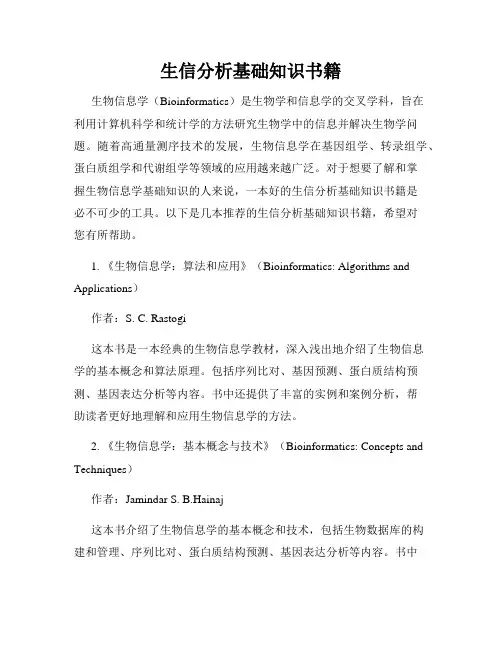
生信分析基础知识书籍生物信息学(Bioinformatics)是生物学和信息学的交叉学科,旨在利用计算机科学和统计学的方法研究生物学中的信息并解决生物学问题。
随着高通量测序技术的发展,生物信息学在基因组学、转录组学、蛋白质组学和代谢组学等领域的应用越来越广泛。
对于想要了解和掌握生物信息学基础知识的人来说,一本好的生信分析基础知识书籍是必不可少的工具。
以下是几本推荐的生信分析基础知识书籍,希望对您有所帮助。
1. 《生物信息学:算法和应用》(Bioinformatics: Algorithms and Applications)作者:S. C. Rastogi这本书是一本经典的生物信息学教材,深入浅出地介绍了生物信息学的基本概念和算法原理。
包括序列比对、基因预测、蛋白质结构预测、基因表达分析等内容。
书中还提供了丰富的实例和案例分析,帮助读者更好地理解和应用生物信息学的方法。
2. 《生物信息学:基本概念与技术》(Bioinformatics: Concepts and Techniques)作者:Jamindar S. B.Hainaj这本书介绍了生物信息学的基本概念和技术,包括生物数据库的构建和管理、序列比对、蛋白质结构预测、基因表达分析等内容。
书中还包含了一些实例和案例分析,帮助读者更好地理解和运用生物信息学的方法。
3. 《生物信息学简介》(An Introduction to Bioinformatics)作者:Arthur M. Lesk这本书是一本全面介绍生物信息学的教材,涵盖了生物数据库的应用、序列比对、基因预测、基因表达分析等内容。
书中给出了大量的例子和案例,帮助读者更好地理解和应用生物信息学技术。
4. 《生物信息学导论》(Introduction to Bioinformatics)作者:Teresa Attwood这本书是一本全面介绍生物信息学的教材,内容包括生物数据库的构建和使用、序列比对、基因预测、蛋白质结构预测、基因表达分析等。
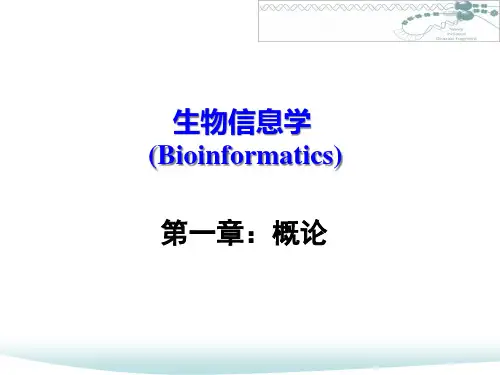
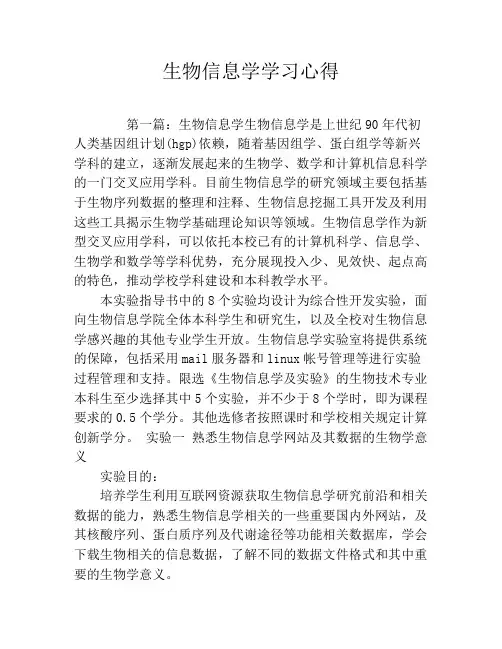
生物信息学学习心得第一篇:生物信息学生物信息学是上世纪90年代初人类基因组计划(hgp)依赖,随着基因组学、蛋白组学等新兴学科的建立,逐渐发展起来的生物学、数学和计算机信息科学的一门交叉应用学科。
目前生物信息学的研究领域主要包括基于生物序列数据的整理和注释、生物信息挖掘工具开发及利用这些工具揭示生物学基础理论知识等领域。
生物信息学作为新型交叉应用学科,可以依托本校已有的计算机科学、信息学、生物学和数学等学科优势,充分展现投入少、见效快、起点高的特色,推动学校学科建设和本科教学水平。
本实验指导书中的8个实验均设计为综合性开发实验,面向生物信息学院全体本科学生和研究生,以及全校对生物信息学感兴趣的其他专业学生开放。
生物信息学实验室将提供系统的保障,包括采用mail服务器和linux帐号管理等进行实验过程管理和支持。
限选《生物信息学及实验》的生物技术专业本科生至少选择其中5个实验,并不少于8个学时,即为课程要求的0.5个学分。
其他选修者按照课时和学校相关规定计算创新学分。
实验一熟悉生物信息学网站及其数据的生物学意义实验目的:培养学生利用互联网资源获取生物信息学研究前沿和相关数据的能力,熟悉生物信息学相关的一些重要国内外网站,及其核酸序列、蛋白质序列及代谢途径等功能相关数据库,学会下载生物相关的信息数据,了解不同的数据文件格式和其中重要的生物学意义。
实验原理:利用互联网资源检索相关的国内外生物信息学相关网站,如:ncbi、sanger、tigr、kegg、swissport、ensemble、中科院北京基因组研究所、北大生物信息学中心等,下载其中相关的数据,如fasta、genbank格式的核算和蛋白质序列、pathway等数据,理解其重要的生物学意义。
实验内容:1.浏览和搜索至少10个国外和至少5个国内生物信息学相关网站,并描述网站特征;2.下载各网站的代表性数据各10条(组)以上,并说明其生物学意义;3.讨论各网站适合做何种生物信息学研究的平台,并设计一个研究设想。
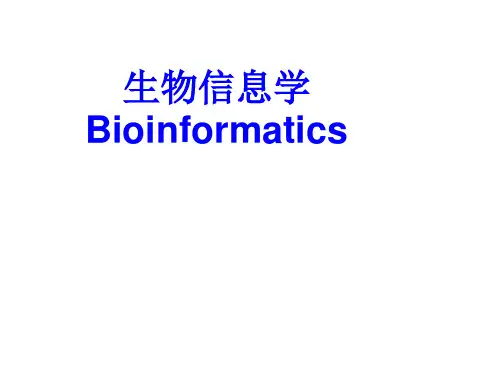

生物信息学简介一. 生物信息学诞生的历史必然性生物信息学(Bioinformatics)就其萌生而言,是一门相当古老的学科,因为早在计算机初创期的1956年就已经在美国田纳西州的Gatlinburg召开过首次“生物学中的信息理论讨论会”;而就其发展而言,却是一门相当年轻的学科,因为继20余年的沉默之后,只有伴随着八九十年代计算机技术的迅猛发展,它才同时得以获得自身的大发展。
无论从理论上来讲还是从现实情况来看,生物信息学的实质就是利用计算机科学和网络技术来解决生物学问题。
它的诞生和发展是应时所需,是历史的必然,已经悄然渗透到生物科学的每一个角落,以至人们在意识到它的存在之前就已经离不开它了!二十世纪尤其是末期,生物科学技术的迅猛发展,无论从数量上还是从质量上,都极大地丰富了生物科学的数据资源,数据资源的急剧膨胀首先迫使我们不得不考虑寻求一种强有力的工具去组织他们,以利于对已知生物学知识的储存和进一步加工利用。
大量多样化的生物学数据资源中必然蕴含着大量重要的生物学规律,这些规律是我们解决许多生命之谜的关键所在,然而继续沿用传统手段以人脑来分析如此庞杂的数据实在是太勉为其难了!人们同样需要寻求一种强有力的工具去协助人脑完成这些分析工作。
可以说,伴随着二十一世纪的到来,生物科学的重点和潜在的突破点已经由二十世纪的试验分析和数据积累转移到数据分析及其指导下的试验验证上来,生物科学也正在经历着一个从分析还原思维到系统整合思维的转变。
那么,我们所寻求的那种强有力的数据处理分析工具就成为未来生物科学的关键所在;似乎是上帝的恩赐,伴随着生物科学这一需求的加剧,以数据处理分析为本质的计算机科学技术和网络技术同样获得了突飞猛进的进展,自然就成为生物科学家的必然选择,计算机科学技术和网络技术日益渗透到生物科学的方方面面,一门崭新的、正是如火如荼的、拥有巨大发展潜力的生物信息学也就悄然而坚定地发展和成熟起来了!可以说,历史必然性的选择了生物信息学——生物科学与计算科学的融合体——作为下一代生物科学研究的重要工具。
一.什么是生物信息学?Genome informatics is a scientific discipline that encompasses all aspects of genome information acquisition, processing, storage, distribution, analysis, and interpretation. (它是一个学科领域,包含着基因组信息的获取、处理、存储、分配、分析和解释的所有方面。
)(The U.S. Human Genome Project: The First Five Y ears FY 1991-1995, by NIH and DOE)生物信息学是把基因组DNA序列信息分析作为源头,破译隐藏在DNA序列中的遗传语言,特别是非编码区的实质;同时在发现了新基因信息之后进行蛋白质空间结构模拟和预测。
生物信息学的研究目标是揭示“基因组信息结构的复杂性及遗传语言的根本规律”。
它是本世纪自然科学和技术科学领域中“基因组、“信息结构”和“复杂性”这三个重大科学问题的有机结合。
How to find the coding regions in rude DNA sequence?By signals or By contentsAmong the types of functional sites in genomic DNA that researchers have sought to recognize are splice sites, start and stop codons, branch points, promoters and terminators of transcription, polyadenylation sites, ribosomal binding sites, topoisomerase II binding sites, topoisomerase I cleavage sites, and various transcription factor binding sites. Local sites such as these are called signals and methods for detecting them may be called signal sensors.二.新基因和新SNPs的发现与鉴定大部分新基因是靠理论方法预测出来的。